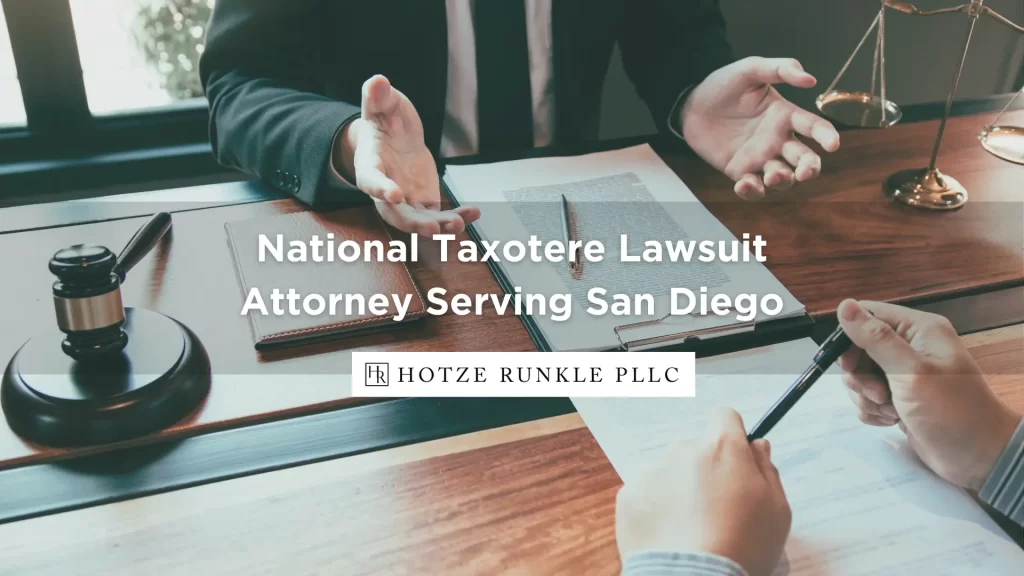
Medical researchers performed studies that show a possible link between Taxotere and excessive eye-watering. Sanofi-Aventis, a pharmaceutical concern, initially manufactured the drug to treat cancer of the breast, head, neck, stomach, prostate, and lung. Patients are administered Taxotere during chemotherapy to attack cancer cells found in the body. It’s effective, but current and former cancer patients discovered unusual side effects.
Lawsuits filed against Sanofi allege that the company was aware of excessive eye-watering and other adverse reactions caused by their drug. Instead of disclosing certain side effects to the U.S. Food and Drug Administration, they continued to market their product to consumers who didn’t know about the potential risks.
If you developed unexpected symptoms after your Taxotere treatment, and need help determining your legal options, take the Hotze Runkle PLLC quiz to discover whether you may be qualified. Our Taxotere excessive eye-watering lawsuit attorneys might be able to pursue financial compensation for your losses.
What are the Symptoms That Taxotere Causes?
If your doctors at UCSD or another hospital have subscribed Taxotere to treat your cancer, you might initially develop symptoms of epiphora. Epiphora is excessive eye-watering resulting from inflammation.
Under normal circumstances, you might develop similar symptoms due to colds or allergies producing more tears because of tear duct inflammation. Since the tear ducts can’t properly funnel the tears into the nasal cavity, excessive eye-watering results. The inflammation eventually clears up on its own.
However, epiphora caused by Taxotere can lead to a more severe medical condition called Canalicular Stenosis. Without early intervention and treatment, vital structures within the eye area called canaliculi become obstructed, and tears are no longer able to travel correctly. If the problem progresses, the canaliculi could close, at which point the condition is permanent.
Most people experience the following symptoms when diagnosed with Canalicular Stenosis:
- Headaches
- Sensitivity to light
- Excessive eye-watering
- Blurred or clouded vision
- Eye infections
- Eyelid swelling
- Central vision loss
- Dry eyes
If you’re suffering from epiphora, it’s crucial to seek treatment from a doctor immediately. Don’t brush off the symptom as normal or something that will pass once you complete chemotherapy. If an ophthalmologist doesn’t evaluate you, your condition could worsen and develop into Canalicular Stenosis. That condition can’t be cured.
Canalicular Stenosis Has No Cure
Unfortunately, once you develop Canalicular Stenosis, it’s irreversible. Your canaliculi become severely obstructed and eventually close, and there isn’t any way to reopen them. An ophthalmologist may be able to help you manage your symptoms.
DCR, dacryocystorhinostomy, is an expensive and invasive surgical procedure developed to create a new passageway for tears to travel. During the surgery, your doctor will use adjacent structures to create a passageway or place a stent above the damaged canaliculus. The tunnel will facilitate the proper flow of tears from the tear ducts into the nasal cavity.
For patients with severe cases of Canalicular Stenosis, DCR isn’t an option. Instead, they might need CDCR (conjunctivodacryocystorhinostomy). During this procedure, the surgeon places a tiny glass tube called a Jones tube so tears can bypass the damaged canaliculus.
Both procedures come with risks and potential side effects that are as debilitating as Canalicular Stenosis symptoms. The risks associated with DCR and CDCR include:
- Damage to nasal structures or tissue
- Injury to the canaliculus
- Blindness
- Sinusitis
- Eye infections
- Hemorrhaging after the procedure
- Displaced or migrating stent
You can continue chemotherapy at an institution like Sharp Memorial while you’re attempting to manage your Canalicular Stenosis symptoms. Keep your doctors updated on the symptoms you’re experiencing so they can monitor your health and prevent them from worsening. You might be able to get a temporary stent near your canaliculus to prevent further damage and allow your tears to funnel to the nasal cavity. Your doctor may remove the stent around six to eight weeks after chemo concludes.
The Reason Taxotere Might Lead to Canalicular Stenosis
While you’re undergoing chemotherapy treatment, your doctor administers the drugs like Taxotere intravenously. As Taxotere travels through the body, it interacts with different bodily fluids, including tears. According to medical researchers, the secretions that come in direct contact with a patient’s tears cause inflammation of the canaliculus.
That adverse reaction between tears and Taxotere secretions can lead to a blockage of the eye structure and prevent tears from funneling through the eye area as usual. Tears that can’t drain properly must be released, so they secrete when the person blinks.
How Much Money Could I Win in a Lawsuit Against Sanofi?
If you decide to file a lawsuit against Sanofi-Aventis for a financial settlement or judgment, you must consider various factors. The most important details used to determine how much compensation victims deserve include:
- Severity of symptoms
- Duration of medically necessary treatment
- Invasiveness of surgery or procedures to treat the injury
- Scarring or disfigurement resulting from the injury
- Length of time spent away from work
- If there was a full recovery or permanent impairment or disability
- Total medical costs
- Availability of sufficient medical evidence
Your attorney will help you determine what damages you can claim resulted from your injury. Damages are losses that fall under two categories: economic and non-economic.
Examples of economic damages include:
- Hospital bills
- Cost of medical treatment
- Out of pocket expenses
- Lost wages
- Lost earning capacity
Examples of non-economic damages include:
- Mental anguish
- Pain and suffering
- Disfigurement or disability
- Loss of quality of life
California follows a two-year statute of limitations. A statute of limitations is a deadline for injured victims to pursue civil action against another party. If you want to sue Sanofi for your diagnosis of Canalicular Stenosis or other related symptoms, you must do so within two years or risk losing your right to compensation in the future.
Why Negligence is an Important Part of a Lawsuit
Most dangerous drug claims use the legal theory of negligence. Negligence refers to a person or entity violating a standard of care required to prevent harm to an individual. Since Sanofi failed to warn consumers about the harm their chemo drug could cause, they were negligent in their duties.
There are five elements of negligence your lawyer must prove to base your case around it:
- The drug company owed you a duty of care;
- They breached their duty;
- If it wasn’t for their actions, you wouldn’t have developed Canalicular Stenosis symptoms;
- Their breach was the direct cause of your symptoms; and
- You incurred damages as a result.
Hotze Runkle PLLC has the resources to locate relevant evidence and show that another party caused our client’s injuries. When you hire us, we’ll perform an investigation and efficiently build a strong case. If your case proceeds to court, we’ll use aggressive tactics to fight against the opposing parties and seek the compensation you deserve.
Besides economic and non-economic damages, we might be able to seek punitive damages. Punitive damages don’t compensate a victim for their losses. Instead, it’s a form of punishment against the liable party for their negligent actions. If the jury believes Sanofi’s actions were especially negligent and you suffered because of it, you could win a financial award for punitive damages.
Why You Need to Hire a Taxotere Excessive Eye-Watering Lawsuit Attorney
 If you’re suffering difficult symptoms, the thought of working with an attorney can be overwhelming. The legal process is complicated and confusing for most people. That’s why you need a good attorney on your side. You have the right to seek compensation in a civil action against the manufacturer of Taxotere.
If you’re suffering difficult symptoms, the thought of working with an attorney can be overwhelming. The legal process is complicated and confusing for most people. That’s why you need a good attorney on your side. You have the right to seek compensation in a civil action against the manufacturer of Taxotere.
Unfortunately, if you don’t hold drug companies liable for their actions, they can continue their careless behavior and harm others. At Hotze Runkle PLLC, we understand the complexities of Taxotere lawsuits, and we’re ready to handle all aspects of your case.
When you hire us, we’ll file a lawsuit on your behalf, prepare the necessary documentation, secure and submit relevant evidence, and prepare your case for trial. We use aggressive tactics to show the jury that negligence occurred and ensure the defendant pays what they owe you.
You won’t have to go through this devastating situation alone. We know you have enough to deal with during your San Diego chemo treatment. Canalicular Stenosis is an additional burden you shouldn’t have to bear. We’ll be by your side throughout your case and provide the support you need.
Choose Hotze Runkle PLLC
Our Taxotere excessive eye-watering lawsuit attorneys believe in providing our clients with excellent customer service. We will treat you with respect and compassion at all times. You can count on our dedicated legal team to give you the individualized attention you need. We’ll update you regularly on the status of your case and maintain open communication. You’ll never feel ignored or abandoned when you’re working with us.
We have experience with cases like yours. We know how to hold parties accountable for their actions and prevent them from hurting other people in the future. When we handle lawsuits, we use our knowledge and skills to move the case through the court system efficiently, so you can get a verdict as soon as possible.
If you suffered an adverse reaction to Taxotere and want to find out if you qualify for a lawsuit against Sanofi, take our quiz today.